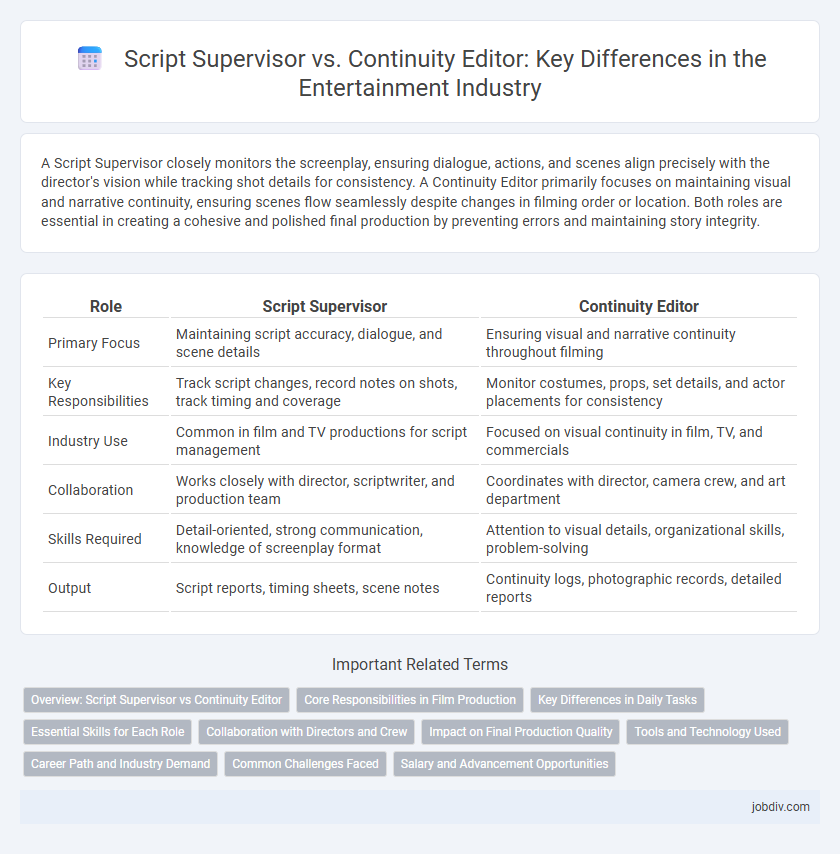A Script Supervisor closely monitors the screenplay, ensuring dialogue, actions, and scenes align precisely with the director's vision while tracking shot details for consistency. A Continuity Editor primarily focuses on maintaining visual and narrative continuity, ensuring scenes flow seamlessly despite changes in filming order or location. Both roles are essential in creating a cohesive and polished final production by preventing errors and maintaining story integrity.
Table of Comparison
| Role | Script Supervisor | Continuity Editor |
|---|---|---|
| Primary Focus | Maintaining script accuracy, dialogue, and scene details | Ensuring visual and narrative continuity throughout filming |
| Key Responsibilities | Track script changes, record notes on shots, track timing and coverage | Monitor costumes, props, set details, and actor placements for consistency |
| Industry Use | Common in film and TV productions for script management | Focused on visual continuity in film, TV, and commercials |
| Collaboration | Works closely with director, scriptwriter, and production team | Coordinates with director, camera crew, and art department |
| Skills Required | Detail-oriented, strong communication, knowledge of screenplay format | Attention to visual details, organizational skills, problem-solving |
| Output | Script reports, timing sheets, scene notes | Continuity logs, photographic records, detailed reports |
Overview: Script Supervisor vs Continuity Editor
A Script Supervisor meticulously tracks all details of script execution, including dialogue accuracy, actor movements, and scene timing to ensure consistency throughout filming. The Continuity Editor focuses on maintaining seamless visual continuity, such as props, costumes, and set design, preventing jarring discrepancies across shots. Both roles are essential for preserving narrative coherence and preventing costly reshoots in film and television production.
Core Responsibilities in Film Production
A Script Supervisor meticulously tracks the script details including dialogue, scene progression, and actor movements to ensure consistency across takes. The Continuity Editor focuses on maintaining visual and narrative coherence, managing props, costumes, and set details to avoid continuity errors during editing. Both roles are crucial for seamless storytelling and play complementary roles in the post-production process to preserve narrative integrity.
Key Differences in Daily Tasks
Script Supervisors meticulously track dialogue, actor movements, and scene details to maintain script accuracy and ensure seamless storytelling. Continuity Editors review footage to identify and correct inconsistencies in props, costumes, and visuals, preserving visual coherence across shots. While Script Supervisors focus on real-time set documentation, Continuity Editors handle post-production continuity adjustments, highlighting distinct roles in the filmmaking workflow.
Essential Skills for Each Role
Script Supervisors require exceptional attention to detail, strong organizational skills, and an in-depth understanding of screenplay structure to track dialogue, actions, and scene progression accurately. Continuity Editors must possess a keen eye for visual and narrative consistency, proficiency in editing software, and the ability to collaborate closely with directors and editors to maintain seamless storytelling throughout the film. Both roles demand excellent communication and time management skills to ensure smooth production workflows and uphold the creative vision.
Collaboration with Directors and Crew
Script Supervisors work closely with directors to ensure the script's integrity by tracking dialogue, blocking, and scene details, facilitating seamless communication with the crew. Continuity Editors collaborate with post-production teams to maintain consistency in visual and narrative elements, bridging the gap between filming and editing phases. Both roles require precise attention to detail and foster strong partnerships with directors and crew to deliver a coherent final product.
Impact on Final Production Quality
The Script Supervisor ensures precise tracking of script details, which directly influences seamless scene transitions and continuity, thereby enhancing the narrative flow and overall production quality. The Continuity Editor focuses on maintaining visual and story consistency during post-production, correcting discrepancies to deliver a polished final cut. Both roles are critical in minimizing errors that could distract audiences, ultimately elevating the professionalism and coherence of the final entertainment product.
Tools and Technology Used
Script Supervisors rely on digital script apps like ScriptE and MovieSlate to track dialogue accuracy, scene timings, and actor movements, ensuring shot-by-shot continuity. Continuity Editors utilize editing software such as Avid Media Composer and Adobe Premiere Pro to review footage, maintain narrative flow, and correct continuity errors during post-production. Both roles integrate video playback technology and digital note-taking tools to synchronize production and post-production workflows effectively.
Career Path and Industry Demand
Script Supervisors and Continuity Editors both play crucial roles in maintaining consistency during film production, but their career paths diverge significantly. Script Supervisors focus on detailed script tracking, scene timing, and performance notes, often starting as assistants and advancing through gaining experience on set, while Continuity Editors work primarily in post-production ensuring seamless narrative flow, typically requiring strong editing skills and industry connections. Industry demand for Script Supervisors remains steady due to on-set necessity, whereas Continuity Editors face increasing competition as digital editing tools evolve, emphasizing adaptability and technical proficiency.
Common Challenges Faced
Script Supervisors and Continuity Editors commonly face challenges such as maintaining accurate scene details amid frequent script changes and ensuring seamless visual and narrative continuity throughout production. Both roles require meticulous attention to camera angles, actor movements, and dialogue variations to prevent continuity errors that could disrupt storytelling. Coordinating between departments under tight schedules often intensifies these challenges, demanding constant communication and organized documentation.
Salary and Advancement Opportunities
Script Supervisors typically earn between $50,000 and $75,000 annually, with advancement opportunities leading to senior supervisory or production management roles. Continuity Editors often have salaries ranging from $40,000 to $65,000, with career progression centered around editorial departments or post-production supervision. Both positions offer paths to higher-paying roles depending on experience, networking, and industry reputation.
Script Supervisor vs Continuity Editor Infographic

 jobdiv.com
jobdiv.com